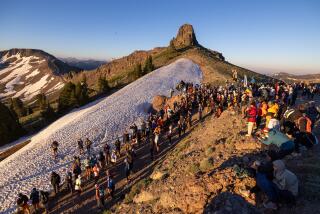Running industry makes strides amid hard times
- Share via
seattle — — Alice Lawson dropped her gym membership in early 2009 to save money and prepare for a possible job loss. Rather than let herself go, she took up running and completed her first half-marathon last month in Seattle.
“We don’t know economically where things are going,” said Lawson, 43. “When I finish a run, I feel like: Hey, I can do whatever I set my mind to. It doesn’t matter what’s coming. I’ll be OK.”
Running is booming in the U.S. as more people seek inexpensive ways to manage stress amid economic uncertainty. The Rock ‘n’ Roll Seattle Marathon on June 26, which featured live bands along a 26.2-mile course from Tukwila, Wash., to Seattle, sold out in late March, roughly a month earlier than last year.
Nationally, the number of marathon finishers rose nearly 10% from 2008 to 2009 to a record 467,000, according to Running USA, a nonprofit group. The growth of half-marathon finishers was even more impressive, jumping 24% from 900,000 in 2008 to 1.1 million in 2009.
The boom also can be seen at running stores, where sales of shoes and other items considered crucial to the sport remain at or above pre-recessionary levels — no small feat, given the economic turmoil of the last two years.
“Running appears to be not recession-proof, but at least it’s recession-resistant,” said David Willey, editor of Runner’s World magazine. “People tend to focus on things they can control, and they want to get healthier, so they start running more.”
Last year, nine Rock ‘n’ Roll Marathon races attracted 219,000 participants in the U.S. Of those, 39% were neophytes and 60% were women, reflecting the broadening appeal of running. This year, 14 Rock ‘n’ Roll races are projected to draw 330,000 participants.
“Running is the most convenient, least costly form of exercise,” said Jim Weber, president and chief executive officer of Brooks Sports Inc., a Bothell, Wash., running shoe and apparel company. “You don’t have to join a health club or take a class. You can just walk out your door.”
Even so, running businesses say they benefit from an affluent customer base who can drop $100 on a new pair of shoes or $85 to enter a race. Running USA figures nearly three-quarters of year-round runners have an annual household income of more than $75,000.
U.S. running-shoe sales rose 2% last year to $2.36 billion, while sales of running apparel declined 3% to $883 million, according to the National Sporting Goods Assn. Store owners blame the recession for the disparity: Cash-strapped runners are more likely to replace a worn-out shoes than a faded shirt or shorts.
“With running, you can wear that ratty old T-shirt, and you can wear cutoffs if you want,” said Chet James, owner of Super Jock ‘n Jill, a specialty running store in Seattle.
Lawson said she figured an $85 race-entry fee was still less than a year of gym-membership dues. To prepare for last month’s half-marathon, she used a website called MapMyRun.com, which helped her create training routes based on how many miles she wanted to cover and whether she preferred a hilly or flat course.
“It’s fun to belong to a gym and take classes, but I didn’t want to pay the price,” she said.
Brooks Sports posted worldwide sales last year of about $190 million, up slightly from 2008. It had sales of $120 million in 2005 and $175 million in 2007, so it’s well ahead of where it was before the recession, Weber said.
Now, Brooks aims to make inroads with first-time marathoners by traveling to Rock ‘n’ Roll races in a carnival-themed, double-decker bus. Called the Run Happy Cavalcade of Curiosities, it mixes games and oddities with the more serious business of gait analysis and product demonstrations.
“We’re spending several million dollars a year on this, which for us is a big investment,” said Dave Larson, vice president of marketing at Brooks. Today’s marathoners “go out not trying to win, but to engage in a fun, communal activity with their friends and family.”
Martinez writes for the Seattle Times/McClatchy.
More to Read
Sign up for Essential California
The most important California stories and recommendations in your inbox every morning.
You may occasionally receive promotional content from the Los Angeles Times.












